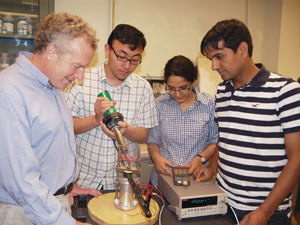Engineers from the University of Minnesota have discovered a new alloy material capable of directly converting heat into electricity. Although this revolutionary energy conversion method is in the early stages of development, it could have a sweeping effect on the production of electricity from waste sources in an environmentally friendly manner.

The researchers claim that the new material can be used to absorb waste heat originating from the exhaust pipes of vehicles, heat that causes the material to heat up and thus produce electricity to charge the battery of hybrid vehicles. Other possible future uses include absorbing heat emitted from power plants and factories or from temperature changes in the oceans in order to generate electricity from them.
"This research is particularly promising because it presents a completely novel method of energy conversion that has not been implemented before," says University of Minnesota professor of aerospace and mechanical engineering Richard James, the lead researcher. "In addition, it is the absolute greenest method for generating electricity since it uses waste heat to generate electricity without receiving carbon dioxide."
In order to obtain the material, the researchers added elements at the atomic level to develop an original alloy whose structural formula is Ni45Co5Mn40Sn10. Alloys of this type, known as Multiferroic, combine unusual elastic, magnetic and electrical properties. This alloy achieves said ability through a highly reversible change of phase transition in which one solid form transforms into a second form. During this phase transition the alloy undergoes changes in its magnetic properties and these changes are utilized in the energy conversion device.
During a small-scale demonstration at the university's lab, the new material started as a non-magnetic material and then suddenly turned into a strongly magnetic material when the temperature was raised slightly. During this change the material absorbs heat and spontaneously produces electricity in the coil. Some of this heat energy is lost during the process, but researchers have found a way to reduce this loss. The research findings were published in the scientific journal Advanced Energy Materials.
A video showing the change of the magnetic material

3 תגובות
waste heat is the heat emitted as an unnecessary product in various machines and harnessing it to produce electricity is the subject under discussion, so it has nothing to do with the title which is meaningless advice.
"Introduces a completely innovative method of energy conversion that has not been implemented before."
If it had been implemented in the past, it would not have been innovative, certainly not completely.
Was the translation of the news into Hebrew done by Google's automatic translator?
The day when organic waste will be worth its weight in gold is getting closer (and not only because the price of gold will always go down in the scale of the next few centuries). Mountains of garbage will be burned and electricity will be produced from them. The emitted gas will be compressed and separated in containers and sold to industry. Carbon dioxide, for example, can be released inside a smart and closed greenhouse where its concentration is much higher than its concentration in the atmosphere and thus the fixation of a carbon molecule per photon will be greater. The gases that cannot be traded can be injected into oil reservoirs in the bowels of the earth.
What a fascinating era…
Ami Bachar